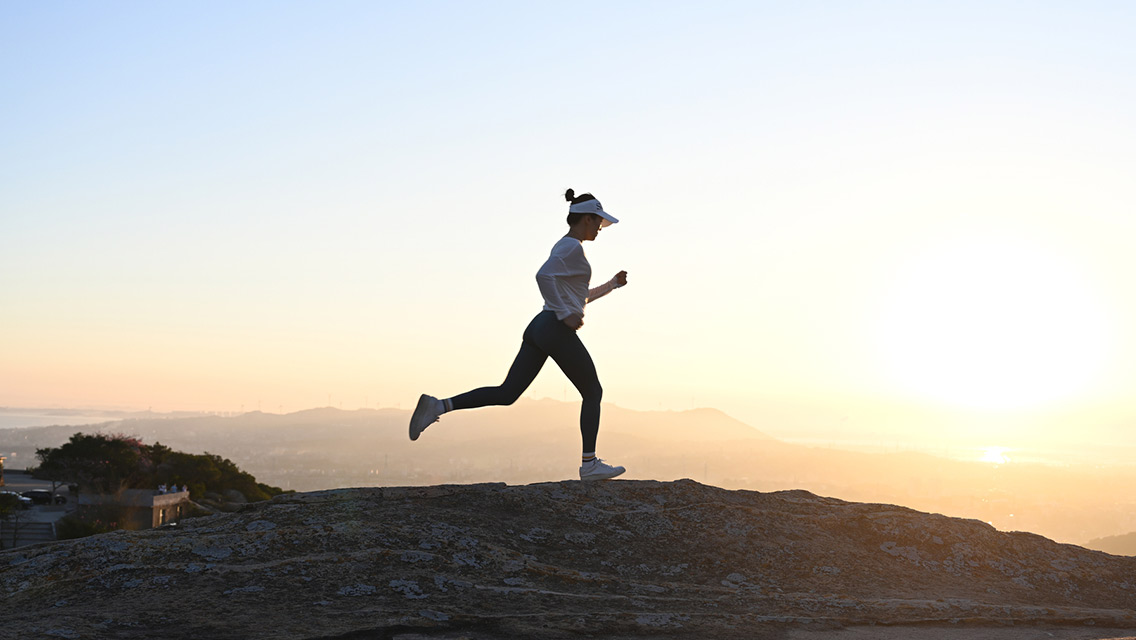After more than 25 years of running, Al Salerno was ready to hang up his shoes. Chronic pain in his iliotibial (IT) band had turned his once-joyful daily run into a painful slog.
Salerno began looking for another sport. One day he was browsing through books on tai chi when a title caught his eye: ChiRunning. Salerno, normally skeptical of the latest training fad, bought the book and began applying the method in a last-ditch effort to salvage his running routine.
“I noticed a change almost immediately,” says Salerno. “Running seemed a lot easier. Within four or five months, the pain in my leg went away. It’s hard to describe, but there are times when I feel like I’m just floating above the ground.”
ChiRunning applies the martial arts principles of posture, balance and mindfulness to our most basic form of aerobic exercise. For some chronically injured athletes, the combination is revelatory: It allows them to experience the joy of running without pain or damage, and over time, it can even help them recover.
“It’s not running that hurts your body, it’s the way you run,” says Danny Dreyer, creator of the ChiRunning technique. “Running has gotten a bad rap and it’s not deserved. People are just moving their bodies incorrectly.”
Moving with Chi
The human body is built to run. We’re equipped with muscular glutei maximi, big tendons, abundant sweat glands and hairless skin that allows us to shed heat and, under some conditions, run longer than even horses, wolves and antelope. For many, however, running is a road to injury. Studies show that every year, between one-third and two-thirds of runners suffer an injury.
Dreyer, 57, developed the ChiRunning technique through a personal odyssey. A former furniture builder, Dreyer started taking tai chi classes in the late 1990s and applied its principles to his running and ultramarathoning. He says he found himself running more smoothly, efficiently and effortlessly. His back problems and knee pain vanished. He set his 3:04 personal marathon record in his early 50s. “My breathing became less labored, my muscles were not getting sore, and many times I would feel better at the end of a run than I did when I started,” Dreyer writes in ChiRunning: A Revolutionary Approach to Effortless, Injury-free Running. “I could go out for a 30-mile run and come back without any major discomfort.”
Core Principles
ChiRunning, like martial arts, relies on a strong core. Dreyer draws on the tai chi concept of centeredness, which holds that all movement and energy flows from the spine – an idea that meshes with the recent focus on core strength in athletic training.
ChiRunning emphasizes a perfectly aligned (but not stiff) body column, an engaged core, a pronounced whole-body lean (to produce gravity-based momentum), and a gentle backward swing of the legs. Many conventional habits (including lifting the knees and forward-driving with the legs and feet) are expressly discouraged.
Essentially, you allow gravity to pull your body forward and down, merely lifting and lowering your feet as you would to prevent yourself from falling. As a result, you conserve the energy of working against gravity and lessen the impact caused by bouncing.
The mind and body work in tandem, so ChiRunning also emphasizes a very conscious integration of form, movement, breathing and relaxation. “It ends up being a type of moving meditation,” says Dreyer.
The ChiRunning concept proved to be a revelation for Cynthia Polakovic, 40, a runner from Falmouth, Mass. Polakovic had been a competitive runner in college and throughout her 20s. In her 30s, she began suffering from a bewildering series of problems in her knees, hips, lower back and sciatic nerve.
She had two knee surgeries. She tried to find relief with massages, orthopedic doctors and chiropractic treatments, but nobody could put their finger on the cause. “I was almost resigned to the fact that I would never run competitively again,” she says.
Then she tried ChiRunning. For Polakovic, the key was aligning her body column, engaging the abdominal and oblique muscles, and leaning her entire body forward from the ankles, rather than running upright and driving ahead with her quads. “Once you have that alignment, everything else falls into place,” she says.
Her pain vanished. “It really reinstilled what it felt like to run without any limitations – like a child, joyously and effortlessly,” she says. “I felt like I was gathering energy rather than expending it. Nothing hurt!”
Many people come to ChiRunning following injuries. Al Salerno outran the IT-band pain that had hobbled him for six years. Now he comfortably logs 30 miles per week, has shed 15 pounds and has seen his race times drop, even though he has cut out interval speed work. He rediscovered the joy that drew him to running so many years ago. “I feel as if I’m in my 20s,” says Salerno, 51. “I’m having a lot of those days where I have a runner’s high that lasts from the first step to the last.”
ChiRunning Technique
Posture – ChiRunning begins with posture. The core of this technique is literally the core of your body. Picture yourself in profile with imaginary dots on your shoulders, hips and ankles. When you stand, the dots should align vertically. When you run, the dots should create a forward-slanted line.
The basics of proper pre-run posture:
- Stand with feet parallel, pointing straight ahead and hip-width apart; soften your knees. Open your chest, and hold your head erect.
- Look down. If you can see your shoelaces, it’s a good bet your shoulders, hips and ankles form a straight line. If you can’t see your shoelaces, place your fingers on your hip bones and use them to push your hips back until you can see your shoelaces.
- Keep your pelvis level. Dreyer cites a metaphor provided by his tai chi master: Think of the pelvis as a bowl that holds Chi, which the Chinese believe is the vital life energy. If the pelvis tips too far forward, the Chi spills.
Lean – Lean your body straight forward from the ankle, like a plank, so that you start to fall. Your leg will reflexively step out to catch you. Dreyer calls this lean the “gas pedal,” because the more you lean, the faster you must move your feet to keep from falling. Keep your core engaged so that you do not bend at the waist. (You can practice the lean against a pole or countertop to get the right body position.)
Movement – When running, retain this straight-body lean. As you move forward, imagine you are being pulled by an invisible cord. Strive to simply pick up and lower your feet in a circular pattern (like you’re riding a tiny bicycle), letting them naturally step forward rather than actively driving with your toes and quads. The lower legs (calves and ankles) should remain loose and relaxed. Land on the midfoot – not the heel – and let your stride open up to the rear. Aim for 85 to 90 strides per minute with each leg. Turnover should remain constant: You adjust speed by stride length and deeper lean, not cadence. Bend elbows at a 90-degree angle and keep hands relaxed.
Not a Runner?
Try ChiWalking instead. Danny Dreyer, coauthor of ChiWalking: The Five Mindful Steps for Lifelong Health and Energy, says ChiWalking is an appropriate method for people who don’t want to run because of injuries, being overweight or simple preference. The technique consists of many of the same principles as his ChiRunning program.
This article originally appeared as “Lean Into It” in the October 2006 issue of Experience Life.




This Post Has 0 Comments